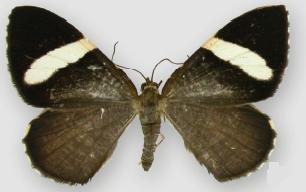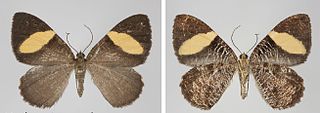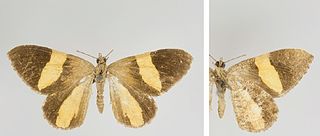
Hagnagora is a genus of moths in the family Geometridae erected by Herbert Druce in 1885.

Hagnagora anicata is a species of moth of the family Geometridae first described by Felder and Rogenhofer in 1875. It is a species complex with a range that extends from Mexico to Bolivia and east into western Venezuela paralleling the Andes. A population occurs on Jamaica. While traditionally considered a single species, DNA barcode and genitalic analyses indicate that five or more species are probably involved in the complex.

Hagnagora elianne is a species of moth of the family Geometridae first described by J. Bolling Sullivan in 2011. It is found in Costa Rica and Honduras.

Phyllodonta esperanza is a moth in the family Geometridae first described by J. Bolling Sullivan in 2014. It is found in the Talamancas and Central Volcanic and Tilarán ranges in Costa Rica, possibly extending into the other Costa Rican mountain ranges and northern Panama. It has been collected at elevations above 1,200 meters.

Phyllodonta intermediata is a moth in the family Geometridae first described by J. Bolling Sullivan in 2014. It is found in the Talamancas and Central Volcanic and Tilarán ranges in Costa Rica, possibly extending into the other Costa Rican mountain ranges and northern Panama. It has been recorded from elevations between 1,275 and 2,280 meters.

Phyllodonta alajuela is a moth in the family Geometridae first described by J. Bolling Sullivan in 2014. It is found in Costa Rica, possibly extending into Nicaragua. It has been recorded from altitudes between 500 and 1,150 meters.

Hagnagora catagrammina is a species of moth of the family Geometridae first described by Herbert Druce in 1885. It is found in Central America, from Nicaragua to Panama.

Hagnagora lex is a species of moth of the family Geometridae first described by Herbert Druce in 1885. It is found in the eastern Ecuadorian Andes.

Hagnagora marionae is a species of moth of the family Geometridae first described by Gunnar Brehm and J. Bolling Sullivan in 2005. It has been collected only at two high mountain areas in Costa Rica at elevations above 2,500 metres (8,200 ft).

Hagnagora richardi is a species of moth of the family Geometridae first described by Gunnar Brehm in 2015. It is only known from a small region around Podocarpus National Park in Zamora-Chinchipe and Loja provinces in Ecuador.

Hagnagora hedwigae is a species of moth of the family Geometridae first described by Gunnar Brehm in 2015. It is only known from southern Ecuador.

Hagnagora clustimena is a species of moth of the family Geometridae first described by Herbert Druce in 1893. It is found in Mexico, Panama, Honduras and Costa Rica.

Hagnagora mirandahenrichae is a species of moth of the family Geometridae first described by Gunnar Brehm in 2015. It is only known from the sectors Santa Maria and Pitilla from Área de Conservación Guanacaste, Guanacaste Province, in north-western Costa Rica.

Hagnagora mortipax is a species of moth of the family Geometridae first described by Arthur Gardiner Butler in 1872. It is found in Costa Rica and Ecuador.
Hagnagora acothysta is a species of moth of the family Geometridae first described by William Schaus in 1901. It is found in Brazil.
Hagnagora guatica is a species of moth of the family Geometridae first described by William Schaus in 1927. It is found in Guatemala.

Hagnagora ephestris is a species of moth of the family Geometridae. It is found in Colombia.

Hagnagora discordata is a species of moth of the family Geometridae first described by Achille Guenée in 1858. Although the type locality is Chile, the species is not thought to be found there. It has been recorded from Santa Catarina in Brazil.

Hagnagora luteoradiata is a species of moth of the family Geometridae first described by Paul Thierry-Mieg in 1892. It is found from Costa Rica to Ecuador.

"Hagnagora" vittata is a species of moth of the family Geometridae first described by Philippi in 1859. It is found in Chile.

















